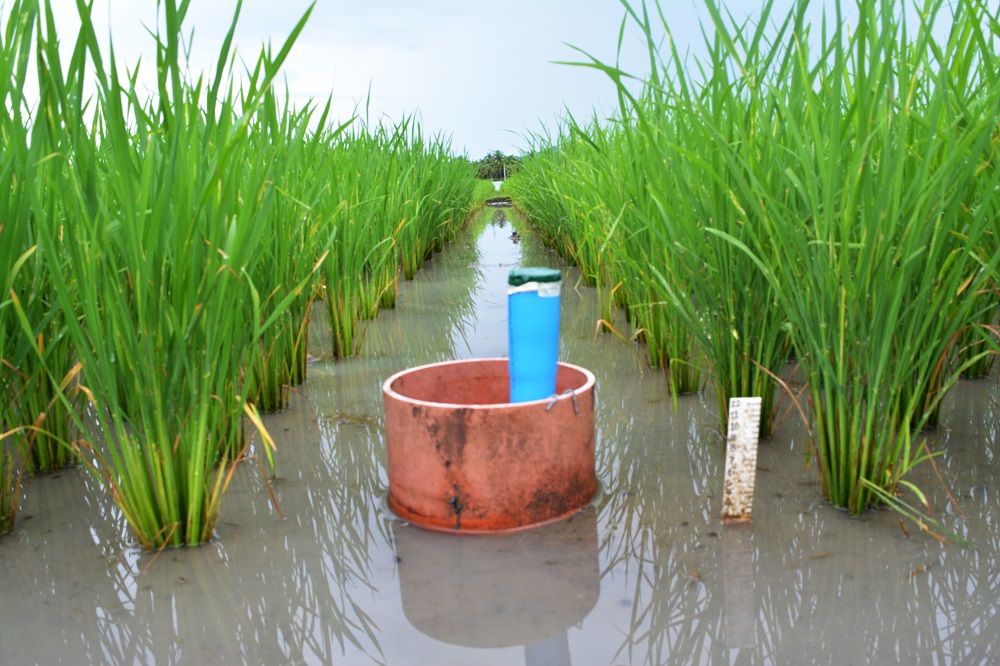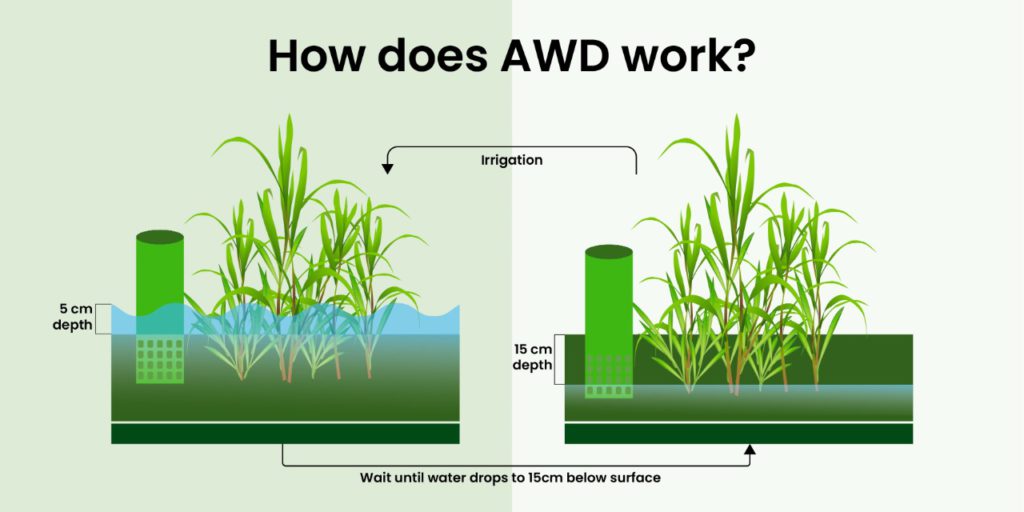Contact: +91 99725 24322 |
Menu
Menu
Quick summary: Do you know that rice cultivation is water-intensive and is dependent on heavy rainfall and a significant source for methane emissions accounting for 9-11 % of GHG emissions in agriculture? Alternate Wetting and Drying Irrigation practice in Rice (AWD) is a water management practice that reduces water use and limits the GHG emissions in irrigated rice fields. Rice farmers not only derive the benefits of water savings but can also enter the Carbon offsets market.

Do you know that Rice farmers can reap additional profits from irrigation conservation practices beyond just water savings? Yes! they have a chance to participate in carbon offset projects that allows for creating carbon offsets through the practice of intermittent flooding and thereby generate carbon credits. Carbon farming is a way towards Climate Resilience in agriculture.
Rice is one of the world’s dominant staple food for more than 3.5 billion people and is critically important for global food security. But, do you know that rice cultivation is water-intensive and is dependent on heavy rainfall and a significant source for methane emissions accounting for 9-11 % of GHG emissions in agriculture. Given the shortage of water for irrigation of crops and environmental concern, there is a need for addressing these issues through technology. Alternate Wetting and Drying Irrigation practice in Rice (AWD) is a water management practice that reduces water use and limits the GHG emissions in irrigated rice fields.

1The vast majority of rice is grown in Asia with a one-fifth to a quarter of it in Southeast Asia, with Indonesia, Thailand and Vietnam being the top producers in the region. Rice cultivation is a major source of livelihood grown on more than 144 million farms. 2The global rice market value was valued at USD 287.45 billion in 2021 and is projected to grow at a CAGR of 2.2% from 2022 to 2028. Asia Pacific is the largest consumer of rice which has led to its significant growth.
75% of rice is cultivated in irrigated lowlands and needs lots of water for its growth. The increasing population and globalization has resulted in water scarcity everywhere. The underground water resources and the surface water is getting depleted, disrupting rice production. The traditional rice cultivation that takes place in flooded soils demands a lot of water compared to other cereal crops. The farmers use a lot of water for land preparation and the growing of crops. The traditional method accounts for 50-80% of water usage. Surface run-off, seepage and percolation accounts for the percentage of water input.

With about 50% of fresh water being used for irrigation and with the need to increase rice production by 70 % by 2030 to feed the growing population, farmers need to adopt new technologies to address water shortages in rice cultivation.
Climate change in the rice value chain will bring serious implications for the livelihood of these farmers and cause food insecurity.

AWD developed by IRRI is a water smart and climate smart technique in rice production. It is a water saving and methane mitigation technology that rice farmers can use to reduce their water consumption during the irrigation of rice. It is based on the principle of flooding and non-flooding of fields alternately during the rice growing period. The number of days of drying the soil in AWD can vary according to the type of soil and cultivar from 1 to 10 days. The frequency of irrigation and duration of non-flooding can be determined by re-irrigation as a threshold of soil water potential is reached and the water table level drops to a certain level.
AWD is also called controlled irrigation. The practical way of implementing this is by monitoring the depth of water table in the field using a simple perforated field water tube. When the water level is 15cm below the surface of the soil, it is time to flood the soil to a depth of around 5cm at the time of flowering , from 1 week before to 1 week after the maximum flowering. The water in the rice field needs to be kept at 5cm depth to avoid any water stress that could result in loss of crop yields. The threshold of water level at 15cm is called ‘ safe AWD’ which will not result in loss of rice yield, as the roots will be able to take the water from the saturated soil. The field water tube helps to measure the water level in the field and thereby monitor the water stress.

A field water tube can be made up of 30cm long PVC pipe, having 15cm diameter so that water table is visible. The field water tube can be perforated on all sides by drilling holes of 5mm diameter spaced 2cm apart. The perforated side is buried in the soil so that 10cm protrudes outside the soil surface. The field water tube is located in such a manner that water level can be monitored easily.
The farmers often dispense with these tubes once they get an idea of water levels. There is also a requirement for proper levelling of rice fields to avoid excessive dry or wet areas that can lead to reduced crop yields. Weed control is also important as no standing water promotes weed growth.
AWD can be practiced in areas where there is reliable water supply to reflood once the area is dried out and maintain the safe AWD levels. AWD cannot be practised in heavy rainfall areas as excess water cannot be drained out and results in crop damage.
Scaling AWD implementation has been challenging due to
Impact on Production
AWD not only saves water but also increases grain yield. Sufficient oxygen is supplied to rice system that increases soil organic matter and hence the soil fertility which helps to realize enhanced yields.
Impact on Water Usage
In AWD, since no continuous standing water is maintained during the crop growth, the number of irrigation events is reduced. There is a net saving of water by 35%.AWD can save up to 660 litres of water per kg of paddy. The farmers are benefitted in water scarce situations and the reduction in water for irrigation helps to utilize fresh water for other usage. Reduced withdrawal of groundwater also saves diesel consumption for water pumps.
Impact on Soil
The drying phase helps root growth and its sustainability for water transport to rice plants even under low soil moisture conditions. Also the drying and wetting of soils alternately releases phosphorus by physical and biological processes. AWD reduces occurrence of lodging and helps plants grow better tillers, thereby increasing soil stability. This also reduces harvesting costs with adoption of mechanical harvesting techniques.
Impact on Climate
Rice cultivation is a major source of methane emissions. AWD reduces the global warming potential of methane and nitrous oxide emissions by 45-90% compared to continuously flooded cultivation. The standing water blocks oxygen from penetrating the soil and promotes growth of methane producing bacteria. Shorter flooding intervals reduces methane emissions by 95%.
Impact on Plant Protection
AWD also reduces infestation of pests and diseases compared to the traditional methods of cultivation. AWD enhances root depth and density making paddy more drought and disease resistant. With improved soil aeration and increased water and nutrient intake, crop growth is regulated.
Impact on Farmers
AWD irrigation practices increase the net profit of farmers by lowering water costs, pumping costs. It enables better tilling with enhanced crop yields. Farmers are able to balance irrigation by knowing the water level status and also achieve reduced methane emissions.

AWD is seen as a potential climate change mitigation and adaptation strategy especially for rice producing countries. AWD provides sustainable rice production especially in drought-resistant areas and regions that require mechanization and crop rotation to increase land productivity. With the reduction in seed and fertilizer application, farmer input costs are reduced, thereby boosting their incomes and making them climate resilient. Emission reductions can be quantified to obtain carbon credits and sell them in voluntary carbon markets.
International organizations like IRRI, IWMI and WorldFish have launched projects in more than 30 communities across Southeast Asia to adopt climate smart agricultural practices to mitigate climate change impacts in rice-based systems.
VNV Advisory leverages TraceX’s blockchain powered traceability solutions to realize farm and crop digitization and the ability to track their AWD irrigation practices. This helps them in realizing sustainable agriculture practices together with GHG mitigation for a greener future.
See how TraceX helps VNV in driving sustainable and climate resilient practices.
Cultivating more rice with less water is critical for food security amid the increasing population. Given that AWD is low cost and easy to implement, they are beneficial for the low income smallholder farmers. Farmers are assured of their livelihoods even in water scarce areas. AWD is a game changer in the context of water crisis, energy crisis and climate crisis. Farmers also get benefited with increased crop yields at lower input costs, thereby enhancing their profitability. The socio-economic and environmental impact nurtures sustainable food production. Scaling up AWD implementation requires coordination among stakeholders through innovations in policy and implementation.